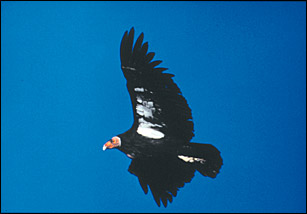California Condors in Arizona Skies
There's a unique experiment going on in the skies over northern Arizona these days. Huge, black vultures—California condors, with wingtips like slender fingers—soar over canyon, desert and forest, circling nimbly on updrafts. Among the rarest birds in the world, the endangered condor is a resourceful pioneer, forging a new path for its species' survival.

The Arizona Condor Recovery Project, sponsored by the Idaho-based Peregrine Fund, has released 35 young birds into the Arizona wilderness since 1996, in an innovative recovery effort to return them to an area that was part of their range less than a century ago. The Fund's field team tracks the fledglings daily using radio telemetry, providing food and intervening in emergencies. Still, the birds face a formidable challenge—they are learning to be wild again, by trial and error.
Since condors were first released in Arizona in 1996, 15 have died and five have been returned to captivity after becoming too friendly with humans. Biologist Shawn Farry, condor project manager for Arizona, says that despite these setbacks the remaining birds are adapting well. The most recent fatalities occurred this summer when at least three birds succumbed to lead poisoning after ingesting shotgun pellets, presumably from carcasses on which they were feeding.
Condors are scavengers, and this new lead risk echoes hazards encountered by condors in California, where captive-bred birds were first released in 1992. California U.S. Fish and Wildlife Service biologist Greg Austin says researchers there have found high lead levels, but there has so far been no evidence of poisoning deaths. Scientists nevertheless count lead poisoning and collisions with power lines the two biggest threats to condors in California. “All of these present-day hazards are human-caused,” Austin says.
Mike Small, wildlife team leader for the Bureau of Land Management in Arizona, says the lead incidents could be indicative of a larger problem. “Condors are the most monitored bird in this part of the world right now. How many other animals are being affected without anyone knowing?”
Lead-free ammunition is available, but hunters have been slow to switch, partly due to increased cost. “The birds have to change and adapt,” says Farry, “but they can't stop being scavengers. We have to change if we want condors around.”
Another dozen birds are scheduled for release in Arizona within a year. In the meantime, some of the older birds are expected to reach sexual maturity soon and may begin to breed in the wild, creating Arizona's first generation of wild condors in 100 years.

